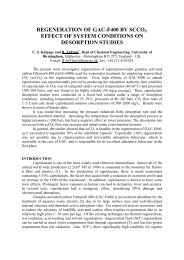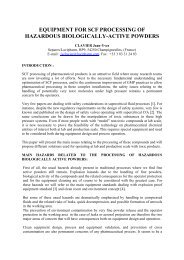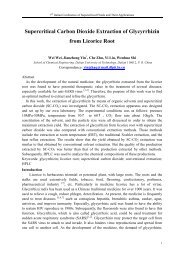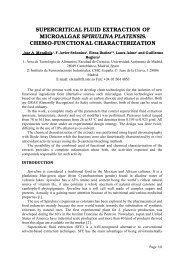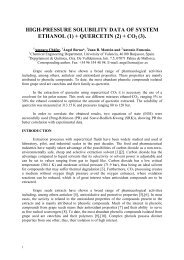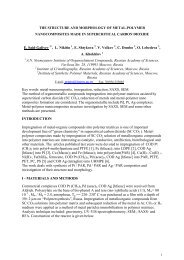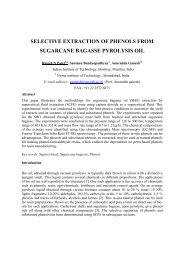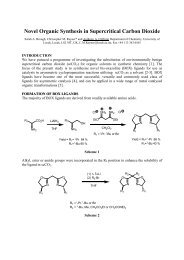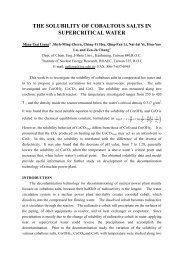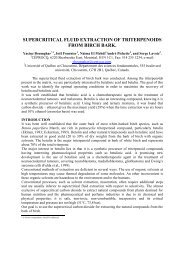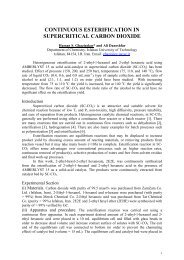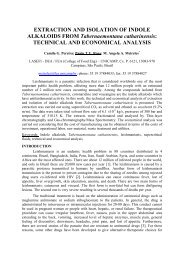PURIFICATION OF WAX ADDITIVES - ISASF
PURIFICATION OF WAX ADDITIVES - ISASF
PURIFICATION OF WAX ADDITIVES - ISASF
You also want an ePaper? Increase the reach of your titles
YUMPU automatically turns print PDFs into web optimized ePapers that Google loves.
It is important to understand the phase behaviour of the alkane, alcohol and the<br />
ethoxylated wax in the propane. It has been proven that the phase behaviour of the alkane in<br />
propane is either type I or type IV [9] according to the classification system of Scott and van<br />
Konynenburg as cited by Bolz et al [10]. The exact phase behaviour cannot be determined as<br />
it is uncertain if a region of liquid-liquid immiscibily occurs (the alkane solidifies before this<br />
region can be seen). The propane-high molecular weight alcohols systems may also be type I<br />
or type IV since the phase boundary curves look similar to that of propane + paraffins. When<br />
the phase transition pressure pressures for the ethoxylated wax + propane is plotted as a<br />
function of mass fraction at various temperatures (Figure 3) it can be seen that above a mass<br />
fraction of about 2.2 mass % the gradient of the isopleth will change from positive to<br />
negative. By implication the system may be classified as type III according to the<br />
classification of Scott and van Konynenburg. A suitable temperature may thus be chosen<br />
where the alcohols and paraffins are fully miscible with propane but where the ethoxylated<br />
waxes are virtually insoluble even at very high pressures.<br />
Pressure (bar)<br />
300<br />
250<br />
200<br />
150<br />
100<br />
50<br />
0<br />
Alkane<br />
Alcohol<br />
Epoxilated<br />
0 0.2 0.4 0.6 0.8 1<br />
Mass Fraction Wax<br />
Pressure (bar)<br />
270<br />
250<br />
230<br />
210<br />
190<br />
170<br />
378 K<br />
393 K<br />
408 K<br />
0.010 0.015 0.020 0.025<br />
Mass Fraction Wax<br />
Figure 2: Phase transition data of<br />
propane + nC39 [9], propane + Unilin<br />
550 alcohol and propane + Unithox 550<br />
ethoxylated wax at 408.1K<br />
Figure 3: Phase transition measurement<br />
of propane + ethoxylated wax at various<br />
tempatures in the low mass fraction wax<br />
region<br />
CONCEPTUAL FLOWSHEET<br />
From the phase transition data it can be seen that the ethoxylated wax could be easily<br />
separated from the alkane and alcohol. A conceptual flowsheet for this separation is given in<br />
figure 4. Due to the ease of separation, a counter-current set-up without reflux is proposed.<br />
The extract stream that exits the extractor is expanded in a two-stage turbine with<br />
interstage re-heating. This is similar to what happens in steam power plants. The power<br />
recovered from these turbines is approximately the same as the power needed by the solvent<br />
recirculation pump. The residue, because of its low propane content, is expanded over a<br />
valve. The extract and residue streams then enter separation vessels where the propane gas is<br />
separated from the liquid products. The liquid products are heated to liberate some more<br />
propane. The liquid products then go to atmospheric flash drums (not shown) where the last<br />
propane is flashed off. Low-pressure steam is used in all of these heaters. The hot propane<br />
gas from the separators exchange heat with the propane from the solvent circulation pump to



